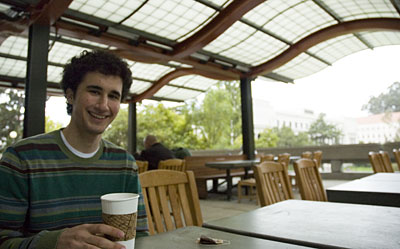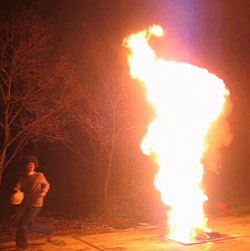UC Berkeley Web Feature
 |
Afrooz Family, a spring '07 admit, is currently working in an atomic physics lab on campus. (BAP photos) |
MadPhysics.com cofounder Afrooz Family enters Berkeley with a bang
BERKELEY – Afrooz Family likes to blow things up. But he's no bomber, just the cofounder of MadPhysics.com, an educational website that features lots of pyrotechnic experiments well documented with photos and videos.
Afrooz also likes to create things, usually when he's bored, he says, which this intellectually hyperactive, irrepressible 18-year-old admits is very rarely.
 Afrooz Family's Berkeley News Widget can be downloaded for free by Mac users from the Apple website. |
Over the summer, during a slow moment, he built a software "widget" that makes it easy for computer users to keep up with UC Berkeley's wealth of news and events. Anyone who uses the Macintosh OS X operating system can download and install the widget from Apple's site for free. The widget, which appears on users' Dashboard, is an attractive mini-website that picks up the NewsCenter and Critic's Choice RSS feeds and displays them in a blue and gold frame under the Berkeley logo, with hints of the University of California seal.
"I tried to make it look as Berkeley as possible," explains Afrooz.
Surprisingly, he isn't even officially a student here yet. He's working as a research assistant in Berkeley physics professor Dmitry Budker's atomic physics lab before starting school in the spring.
Gregarious and not exactly shy, Afrooz has already assembled a respectable number of Facebook friends at Berkeley, despite living off campus. He's attended his first-ever football game — "I love that Berkeley is a top-tier school where students still have school spirit" — and a Massive Attack concert at the Greek Theatre. (He was disappointed that Yo-Yo Ma tickets for Zellerbach Hall were already sold out.) Still, he's looking forward to starting classes. On his list of possibilities: an upper-division course about musical applications of computers and related technologies. Naturally, he's already zipping through his future textbooks.
Family guy
Afrooz was born and raised in Atlanta, to parents from Iran. His surname is not a traditional Persian one. "I don't think 'Family' is a normal name in any culture," he says cheerfully, before admitting that the reaction to his unusual name can get a little wearing.
His father, a physics professor at Emory University, gave Afrooz his first computer — a Macintosh — when he was 4. "He set it up in my bedroom and showed me how to turn it on," recalls Afrooz. "That was it."
By age 6 he was troubleshooting his mother's Mac. At age 13, he was visiting his dad in the physics department, where he noticed a professor "really pulling his hair out about this computational software that wasn't working." Afrooz managed to fix it, ending up with a summer job that turned into two years' worth of computer support. By his senior year at Atlanta's International School — he graduated with an International Baccalaureate diploma — he was helping out with research in the immunology department.
Jumping ahead
 Afrooz Family (whose hair used to be a lot bigger) dodges the 20-foot wax fireball, a don't-try-this-at-home Mad Physics lab that illustrates the concepts of phase change and density. |
The idea for MadPhysics.com came about when Afrooz was still a junior in high school, trying to plan a lab report with his buddy Joost ten Lohuis. They searched online, and were disappointed to find no websites with good explanations of physics problems "that were also interesting. So we decided to build one."
They launched the website in May 2005. Among the projects listed are how to make fireballs from nondairy creamer (illustrating the power of free radicals), melting magnesium (at 2,200ºC, producing an impressive white light), and exploding dry ice (change of state and volume), to name just a few of the hair-raising — and eyebrow-singeing — experiments they conducted in their parents' back yards and living rooms. Each one is documented with clear descriptions of the principles being demonstrated, step-by-step instructions, sample citations for papers, and photos and short videos.
Afrooz and Joost were amazed by how many hits they immediately started getting. Intended as a goof that they could share with their friends, the site now receives as many as 70,000 visitors a day. CollegeHumor.com has linked to some of the videos, as have more serious websites.
"Carleton College put our Wilson Cloud Chamber experiment on their physics lab course resources list," says Afrooz. "I thought that was so cool!"
Even cooler was when ABC News and other news outlets around the world used Mad Physics to debunk the idea of "World Jump Day" — an Internet-spread hoax perpetrated by a German artist claiming that if 600 million people were to jump simultaneously on July 20, 2006, they could shift the Earth's position and stop global warming.
"If we are to assume that because some unnamed man with uncited research claims that bouncing will change our ecosystem, you have to take it with an enormous grain of salt," Afrooz sniffed in a post for Mad Physics, before disproving the argument using numbers and basic physics. For this, he was interviewed by TV news shows in Australia, China, and even Iran.
| 'I was shocked when I saw who teaches [at
Berkeley] and the research that goes on. It's such an intellectually
exciting place.' -Afrooz Family |
Mad Physics also led to one of Afrooz's "greatest experiences ever": an invitation to be the featured speaker for a big science summer camp for an Australian high school in Sydney. He took 10 days off from work at Emory, flew from Atlanta to Los Angeles to Auckland to Sydney, and enjoyed giving presentations about hands-on science to school kids age 4 to 13.
Just say Nobel
As of April, Afrooz still wasn't sure whether he wanted to go to UC Berkeley or the University of Chicago. He bought plane tickets for both, and went to Berkeley first.
"I felt so at home, I canceled my ticket to Chicago," he says. His adviser had said that at Berkeley, he'd find students who were even more impressive than the professors, but for the moment Afrooz is still blindsided by the faculty. "I was shocked when I saw who teaches here and the research that goes on. It's such an intellectually exciting place."
Having grown up around legendary physics researchers — such as Benoit Mandelbrot, creator of the discipline-crossover hit Mandelbrot fractal sets, and Pierre-Gilles de Gennes, winner of the 1991 Nobel Prize in physics — he claims not to be easily impressed. Yet when UC Berkeley professor George Smoot won the Nobel Prize for Physics a few weeks ago, Afrooz excitedly played paparazzo at the physics department reception, later posting a slide show to Mad Physics.
"Here's what I like about this university," he says. "I've only been working in Budker's lab a short time, but I can tell he's the smartest, most talented scientist I've ever seen, and he's also the nicest, most down-to-earth humble guy. He teaches students every semester, but he wrote the textbook."
The job in Budker's lab came serendipitously, through a recommendation by a friend in the Emory physics department. "It's a dream job for me, because it's really experimental and super hands on," Afrooz says.
He's helping out with experiments having to do with parity nonconservation in ytterbium. Asked to put that in layperson terms, he gives a concise explanation of how light waves work — unbroken by any single "um" or "like" — then says, "We heat the element in a vacuum chamber and shoot this beam to excite individual atoms with these lasers. By looking at these emissions and noticing certain violations in behavior, we can possibly discover some things about the fundamental interactions of atoms and subatomic particles."
After less than two months in the lab, Afrooz has proved himself a "keeper," Budker, the lab's head, said in a phone interview. "He's very remarkable. He has a broad knowledge of things from music to languages to computing to physics, and he's just a totally charming and exciting person to have in the group. He's also been working very hard, and making a lot of progress in learning the complicated experiment we're doing right now."
Told of Budker's comments, Afrooz is flattered, but insists anyone can do research if they try.
"I've noticed that if you just throw yourself into something, you can stay afloat, but when you have a lot of trepidation, it's hard to learn anything," he argues. "I'm not a scientist yet, but if you're curious and ask questions you'll feel right at home in any lab. You just have to look at things from a naïve perspective, and ask 'Why is it this way, and not this way?' That's when things get really interesting."

